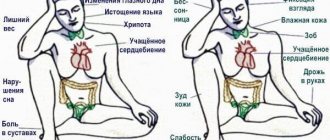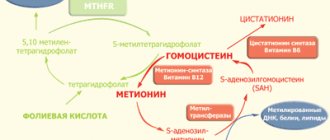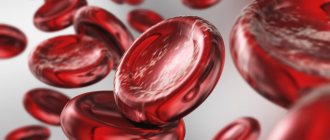What is homocysteine
Amino acids are the molecules that make up proteins.
There are about 500 different amino acids in the world, but only 22 are used to build all the proteins necessary for various organisms. Such amino acids are called proteinogenic. All other amino acids are formed as intermediate products of certain reactions. Homocysteine is an intermediate product of the metabolism of the proteinogenic amino acids methionine and cysteine. It does not enter the body with food, but is formed from methionine during reactions necessary for the normal functioning of our body. The resulting homocysteine can either be converted back into methionine or into another important amino acid, cysteine. These reactions occur thanks to enzymes, the adequate functioning of which requires vitamins B6, B12, as well as folic acid.
Thus, methionine, homocysteine, cysteine, some enzymes, as well as vitamins B6, B12 and folic acid are participants in the same process. Changes in the functioning of these components can lead to an increase in homocysteine.
Folate cycle genes: where is the myth and where is the reality?
When do homocysteine levels increase?
Hyperhomocysteinemia is an increased level of homocysteine in the blood: above 15 µmol/l.
Why is this happening?:
- Enzyme disruption . Homocysteine levels rise because enzymes cannot convert it into other amino acids. Such violations are rare, but can lead to serious complications. For example, a defect in the enzyme cystathionine beta synthase leads to changes in the lens, problems with intelligence and the early development of atherosclerosis.
- Lack of vitamins. If the body does not have enough vitamins B6, B9 and B12, then even enzymes with normal activity will not be able to work correctly. The cause of vitamin deficiency may be problems with intestinal function, alcoholism, liver disease and insufficient intake of vitamins from food.
- Renal dysfunction. The exact mechanism is unknown, but it may be related to impaired homocysteine excretion.
Treatment of hyperhomocysteinemia
If hyperhomocysteinemia is detected, specially selected therapy is carried out with high doses of folic acid and B vitamins (B6, B12, B1). Considering that in many cases a vitamin deficiency state is associated with impaired absorption of vitamins in the gastrointestinal tract, treatment usually begins with intramuscular administration of B vitamins. After homocysteine levels have decreased to normal (5-15 mcg/ml), maintenance doses are prescribed vitamins per os
.
During pregnancy, antiplatelet therapy may be indicated (small doses of aspirin, which in this case acts as a kind of pregnancy vitamin, small doses of heparin drugs). If antiphospholipid syndrome is present, additional treatment may be prescribed.
Hyperhomocysteinemia is a pathological condition, the timely diagnosis of which in the vast majority of cases makes it possible to prescribe simple, safe and effective treatment, which reduces the risk of complications in mother and child tenfold.
Tags: pregnancy, homocysteine
How homocysteine levels are related to genetics
Different genetic variants affect how enzymes work. There are several main genes that affect homocysteine levels: MTHFR, CBS, MTR, MTRR. In this article we will look at the CBS and MTHFR genes.
A hereditary disease caused by a mutation in the CBS gene is called homocystinuria. The CBS gene encodes the enzyme cystathionine beta synthase, which converts homocysteine to cystathionine. This is one of the pathways for homocysteine metabolism. The presence of a defect leads to the fact that the reaction does not occur and the chain of sequential transformations of amino acids is disrupted. As a result, the levels of homocysteine and methionine increase in the blood and urine.
Homocystinuria is a rare disease. Although it may not be noticeable in the first years of life, vision problems, osteoporosis, thrombosis and stroke may develop in the future.
Another gene involved in homocysteine metabolism is called MTHFR. It affects the activity of the enzyme that converts vitamin B9 into its active form. The active form of vitamin B9 is involved in the conversion of homocysteine into another amino acid - methionine. Thus, the normal cycle of homocysteine metabolism is maintained.
There are several variants of the MTHFR gene. People with the C677T and A1298C variants have decreased enzyme activity, which can affect homocysteine levels.
A number of studies show that the C677T genetic variant is associated with the development of cardiovascular and neurological diseases. However, it cannot be said that the presence of this gene variant becomes a direct cause of disease. Many data are inconsistent and require further study. It is also important to note that homocysteine levels are also influenced by other genes, including those responsible for the transport of B vitamins. Therefore, it is necessary to take into account all factors and conduct an individual consultation with a doctor.
You can find out about your own risks associated with genetics using the Atlas Genetic Test.
Homocysteine is a predictor of pathological changes in the human body
Homocysteine (Hcy) is a naturally occurring sulfur-containing amino acid not found in proteins. Hcy is a metabolic product of methionine (Met), one of the 8 essential amino acids in the body.
In blood plasma, free (reduced) Hcy is present in small amounts of 1–2% (Fig. 1). Approximately 20% is in the oxidized state, mainly in the form of a mixed disulfide of cysteinyl homocysteine and homocystine. About 80% of Hcy binds to blood plasma proteins, mainly albumin, forming a disulfide bond with cysteine-34.
The metabolism of homocysteine occurs with the participation of a number of enzymes, the main of which are: methylenetetrahydrofolate reductase (MTHFR) and cystathione-β-synthetase (CBC).
In addition to enzymes, vitamins B6, B12 and folic acid play an important role in the metabolism of homocysteine.
Met is converted to S-adenosylmethionine (SAM) by the enzyme methionine adenosyltransferase. As a result of methylation reactions carried out by methyltransferases, SAM is converted to S-adenosylhomocysteine (SAH). SAH is subsequently hydrolyzed by SAH hydrolase to form Hcy and adenosine. This cascade of enzymatic reactions, referred to as transmethylation, occurs in almost every cell of the human body.
SAM-dependent transmethylation reactions are important for a variety of cellular processes, such as methylation of nucleic acids, proteins and phospholipids.
There are several pathways for the biotransformation of Hcy in the human body [6]. It can be converted back to Met in two ways (Figure 2). First, Met can be reduced from Hcy by methionine synthase (MS), which uses 5-methyl-tetrahydrofolate (5-MeTHF) as a methyl group donor. This remethylation pathway is ubiquitous, primarily in liver cells and, in some species, in the kidney. Second, glycine-betaine (NNN-trimethylglycine) can also be remethylated to Met by betaine homocysteine methyltransferase (BHMT). Hcy can also be converted to cysteine. Under the action of cystathionine-β-synthase, Hcy and serine form cystathionine, which can be degraded by cystathionine-γ-lyase to cysteine and α-ketobutyrate, which is further metabolized by enzymes to succinyl-CoA. This series of reactions that convert Hcy to cysteine occurs in the liver, kidneys, small intestine, and pancreas. Hcy can also be excreted from cells into the blood, but transporters for this process have not yet been identified.
These two pathways of Hcy conversion (remethylation to Met, requiring folate and B12, and conversion to cystathionine, requiring pyrodoxal phosphate) are coordinated by S-adenosylmethionine, which acts as an allosteric inhibitor of methylenetetrahydrofolate reductase and as an activator of cystathionine-b-synthase.
In numerous population studies, the lower limit for homocysteine levels is usually determined fairly clearly (5 μmol/L), but the upper limit usually varies between 10 and 20 mmol/L - depending on age, gender, ethnic group and folate intake patterns.
Various hereditary and acquired disorders in the body lead to the fact that Hcy is not utilized. In this case, it accumulates in the body and becomes dangerous for it, causing a number of pathological effects. There are several forms of hyperhomocysteinemia (HHC) [2].
Severe form of HHC (>100
m
mol/l)
The reason may be:
– hereditary homocysteinuria, for example, due to homozygosity for defective genes for enzymes of methionine biosynthesis - cystathionine-b-synthase or 5,10-methylenetetrahydrofolate reductase;
– hereditary disorders of vitamin B12 utilization;
– severe vitamin B12 deficiency.
Moderate form of HHC (30–100
m mol/l)
Causes:
– severe renal dysfunction (reduced clearance of homocysteine by the kidneys);
– moderate B12 deficiency;
– severe folate deficiency.
Mild form of HHC (10–30 μmol/l)
Reasons may include:
– -heterozygosity for a defective cystathionine-b-synthase gene;
– homozygosity for the C677T base substitution in the 5,10-methylenetetrahydrofolate reductase gene;
– renal failure;
– kidney transplantation;
– slight deficiency of folate and vitamin B12;
– lack of thyroid hormones;
– alcoholism;
– medicines.
Hcy metabolism is highly dependent on cofactors - vitamin derivatives. Therefore, deficiency of any of the vitamins (B12, folic acid and B6) can lead to HHC.
Genetic mutations can also cause hyperhomocysteinemia, in particular, defects in the enzymes cystathionine β-synthase and cystathionine γ-lyase or methylenetetrahydrofolate reductase.
When studying polymorphism in the methylenetetrahydrofolate reductase (MTHER) gene associated with the 677C→T substitution, it was found that 10–16% of the population have homozygosity for the TT variant, and carriers of this variant are characterized by an increased Hcy content. If individuals who are genetically predisposed to elevated Hcy levels smoke and drink a lot of coffee, they become especially sensitive to increased Hcy concentrations. The genotype with the 677C→T substitution in the MTHER gene is predisposed to an increased risk of neural tube defects and cardiovascular diseases [7,8].
Research over the past 15 years has established that homocysteine is a ranked independent risk factor for cardiovascular diseases (CVD) - myocardial infarction, stroke and venous thromboembolism, atherosclerosis [9,10]. It is believed that hyperhomocysteinemia is a more informative indicator of the development of diseases of the cardiovascular system than cholesterol [11].
Hcy damages the walls of blood vessels, making their surface loose. Cholesterol and calcium are deposited on the damaged surface, forming an atherosclerotic plaque. Elevated Hcy levels increase thrombus formation. An increase in blood homocysteine levels by 5 µmol/l leads to an increase in the risk of atherosclerotic vascular damage by 80% in women and 60% in men.
By inhibiting the work of the anticoagulant system, homocysteinemia is one of the links in the pathogenesis of early thrombovascular disease; in its presence, the risk of developing thrombosis and deep veins increases. Patients with diabetes are at particular risk.
It has been shown that with an increase in plasma Hcy levels by 2.5 μmol/L, the risk of myocardial infarction increases by 10%, and the risk of stroke by 20% [12]. Elevated homocysteine levels are a strong predictor of mortality in people with pre-existing CVD or known other risk factors [13].
The mechanisms of influence of homocysteinemia on blood vessels may include damage due to oxidative stress, disturbances in the release of nitric oxide, changes in homeostasis and activation of inflammatory pathways.
It is also possible that high Hcy levels are only a marker of CVD, that is, the connection between them is mediated by other factors (impaired kidney function, deficiency of folate and vitamins B12 and B6), which affect both the level of Hcy and the development of vascular diseases.
Hyperhomocysteinemia is common among patients with chronic renal failure (where kidney function is reduced, but not so low that replacement therapy is required) and is almost always observed in end-stage renal disease [14]. This fact is especially important for some patients who have cardiovascular failure: their risk of death increases 30 times compared to the main group of patients.
In renal failure, Hcy levels increase, and the majority of dialysis patients (>85%) exhibit a mild degree of hyperhomocysteinemia. Creatinine clearance, which determines the presence of renal failure, inversely correlates with plasma Hcy levels. Studies conducted in healthy people and diabetic patients have confirmed the inverse relationship between Hcy levels and renal function, as well as the role of creatinine as a marker of renal failure [15].
Microthrombi formation leads to disruption of the uterine and fetoplacental circulation, which can cause infertility and miscarriage, and therefore determination of the Hcy level is relevant in obstetric practice for predicting possible complications during pregnancy and childbirth. Changes in Hcy levels may be associated with folate deficiency, which has multiple effects on fetal development [16]. In later stages of pregnancy, hyperhomocysteinemia causes the development of chronic fetoplacental insufficiency, chronic intrauterine fetal hypoxia, and, as a consequence, intrauterine fetal hypotrophy. An increase in homocysteine levels is one of the reasons for the birth of children with developmental defects (neural tube defects). In view of these circumstances, it is recommended to check the level of homocysteine in women giving birth with previous obstetric complications or who have relatives who had strokes, heart attacks and thrombosis at a fairly early age.
There are a number of premises indicating a connection between increased homocysteine levels and impaired cognitive function and mental disorders. An increase in the level of Hcy in the blood to 14.5 μmol/L leads to a twofold increase in the risk of Alzheimer's disease at the age of over 60 years [17]. It has been shown that an increase in Hcy concentration in the blood directly correlates with cognitive disorders in elderly people [18].
Among the factors influencing the content of homocysteine in the blood, the above-described genetic predisposition to increased Hcy levels, smoking, and diet (consumption of large amounts of protein foods, coffee, B vitamins, folates) should be highlighted.
Population studies have made it possible to analyze the relationship between dietary factors (B vitamins, proteins and methionine), smoking, coffee consumption, biochemical determinants (plasma creatinine, B6, B12, folate) and other factors (body mass index, blood pressure and antihypertensive drugs) with homocysteine levels. Apart from blood pressure, all other factors were associated with Hcy content. For example, in smokers the Hcy content was 1.5 μmol/L higher than in non-smokers. Folate content was the strongest determinant of Hcy levels. The differences in Hcy levels at the highest and lowest folate concentrations were 4 μmol/L, and under the influence of other factors were in the range of 0.5–2.0 μmol/L. The determinants of Hcy content varied greatly depending on gender and age, as well as on the characteristics of the national diet in different countries associated with the content of B vitamins [19].
The most common cause of HHC is folic acid deficiency, as well as a lack of vitamin B
12, which, even with sufficient folic acid intake, can lead to homocysteine accumulation.
Some drugs (eg, penicillamine, cyclosporine, methotrexate, carbamazepine, phenytoin, 6-azauridine, nitrous oxide) may increase homocysteine levels. The mechanism of action of these factors is due to either direct or indirect antagonism with enzymes or cofactors involved in Hcy metabolism.
The reasons for the increase in Hcy content in the blood can be a number of diseases (chronic renal failure, hypofunction of the thyroid gland, B12-deficiency anemia, cancer).
The effect of physical activity on Hcy levels is controversial. Thus, it has been shown [20] that after a marathon, runners (with the exception of professional athletes) experience a sharp increase in Hcy content in the body. In other studies, the increase in Hcy concentration observed in athletes is associated with diet [21]. Dosed intake of vitamins B6, B12 and folic acid helps prevent possible complications.
Although homocysteine-lowering therapy has not yet been definitively proven to reduce the risk of CVD, it is inexpensive and continues to be used. The goal of therapy should be to reduce homocysteine levels in patients at high risk of heart disease to 10 μmol/L
.
In patients with low to moderate hyperhomocysthenia, Hcy levels can be reduced to normal levels by administering either folic acid 0.4 to 5 mg/day, vitamin B12 0.5 to 1 mg/day, or both. drug. Treatment is less effective in patients with kidney disease.
It is generally accepted to use folic acid, folic acid in combination with vitamins B6 and B12 and a combination of vitamins B6 and B12, and the use of drugs such as cardonate (a combination drug containing coenzymes B1, B6, B12, as well as carnitine and lysine) for the treatment of homocysteinemia. Folic acid, originally found in spinach, is present in most plant foods that have leaves (hence its name, from the Latin word folium - leaf), green vegetables, fish and liver.
But there is evidence that therapeutic intervention for elevated Hcy levels should not be limited to replenishing vitamin and folate deficiencies and combating well-known risk factors such as smoking and excess coffee consumption.
Thus, it has been shown that therapy with high doses of folic acid, vitamins B6 and B12 does not reduce mortality and the incidence of cardiovascular events in patients with severe renal failure, and therefore cannot be recommended for this purpose. Moreover, when exogenous folic acid is administered, there is a short-term increase in Hcy levels. Among the possible reasons for the low effectiveness of vitamin therapy, the authors note the exceptional clinical severity and poor short-term prognosis of the included patients, the achievement of normal Hcy levels in only a third of the participants, and the side effects of vitamin therapy that neutralize its beneficial effect. The authors believe that one of the reasons for the failure to reduce Hcy is that its level is a marker and not a cause of CVD [22].
A promising direction in the treatment of homocysteinemia may be the use of hydroxymethylglutaryl-CoA reductase inhibitors (statins). There is evidence to suggest that a decrease in homocysteine levels is one of the effects of statin use in patients with CVD [23].
In conclusion, it should be noted that an increase in the level of Hcy in the blood is associated both with an increase in mortality in the population in general, and with diseases of the cardiovascular system, in particular [24]. According to some estimates, if Hcy levels could be reduced by 40%, this would lead to the preservation of 8 years of life per 1000 men and 4 years of life per 1000 women. This circumstance stimulates the introduction of Hcy concentration monitoring into widespread clinical practice.
References 1. Friedman AN, Bostom AG, Selhub J. et al. The kidney and homocysteine metabolism. J. Am Soc. Nephrol., 2001, v. 12, p. 2181–2189. 2. Lentz SR, Haynes WG Homocysteine: Is it a clinically important cardiovascular risk factor? Clev. Clin. J. Med., 2004, v. 71, p. 729–734. 3. Daly S., Cotter A., Molloy AE, Scott J. Homocysteine and folic acid: implications for pregnancy. Semin. Vasc. Med., 2005, v. 5, p. 190–200. 4. Ciaccio M., Bivona G., Bellia C. Therapeutic approach to plasma homocysteine and cardiovascular risk reduction Therapeutics. and Clin. Risk Manag., 2008, v. 4, p. 219–224. 5. Vollset SE, Refsum H., Ueland PM Population determinants of homocysteine. Am J. Clin Nutr., 2001, v. 73, p. 499–500. 6. Szegedi SS, Castro CC, Koutmos M., Garrow TA Betaine–homocysteine s–methyltransferase–2 is an s–methylmethionine–homocysteine methyltransferase. J Biol. Chem., 2008, v. 283, p. 8939–8945. 7. Kraus JP Biochemistry and molecular genetics of cystathionine beta-synthase deficiency. Eur. J. Pediatr., 1998, v. 157, p. 50–53. 8. Trabetti E. Homocysteine, MTHFR gene polymorphisms, and cardio-cerebrovascular risk. J. Appl. Genet., 2008, v. 49, p. 267–282. 9. Naess IA, Christiansen SC, Romundstad PR et al. Prospective study of homocysteine and MTHFR 677TT genotype and risk for venous thrombosis in a general population—results from the HUNT 2 study. Br. J. Haematol., 2008, v. 141, p. 529–535. 10. Moat SJ Plasma total homocysteine: instigator or indicator of cardiovascular disease? Ann. Clin. Biochem., 2008, v. 45, p. 345–348. 11. Potter K. Homocysteine and cardiovascular disease: should we treat? Clin. Biochem. Rev., 2008, v. 29, p. 27–30. 12. Virtanen JK, Voutilainen S., Alfthan G. Homocysteine as a risk factor for CVD mortality in men with other CVD risk factors: the Kuopio Ischemic Heart Disease Risk Factors (KIHD) Study. J. Intl. Med., 2005, v. 257, p. 255–262. 13. Homocysteine Studies Collaboration. Homocysteine and risk of ischemic heart disease and stroke: a meta-analysis. JAMA, 2002, v. 288, p. 2015–2022. 14. Bostom AG, Culleton BF Hyperhomocysteinemia in chronic renal disease. J. Am. Soc. Nephrol., 1999, v. 10, p. 891–900. 15. Bostom AG, Kronenberg F., Schwenger V. et al. Proteinuria and total plasma homocysteine levels in chronic renal disease patients with a normal range serum creatinine: Critical impact of true GFR. J. Am. Soc. Nephrol., 2000, v. 11, p. 305–310. 16. Beaudin AE, Stover PJ. Folate–mediated one–carbon metabolism and neural tube defects: balancing genome synthesis and gene expression. Birth. Defects Res. C. Embryo Today., 2007, v. 81, p. 183–203. 17. Kidd PM Alzheimer's disease, amnestic mild cognitive impairment, and age–associated memory impairment: current understanding and progress toward integrative prevention. Altern. Med. Rev., 2008, v. 13, p. 85–115. 18. Schafer JH, Glass TA, Bolla KI et al. Homocysteine and Cognitive Function in a Population–based Study of Older Adults. J. Am. Geriatr. Soc., 2005, v. 53, p. 381–388. 19. Tolmunen T., Hintikka J., Voutilainen S. et al. Association between depressive symptoms and serum concentrations of homocysteine in men: a population study. Am. J. Clin. Nutr., 2004, v. 80, p. 1574–1578. 20. Real JT, Merchante A, Gomez JL et al. Effects of marathon running on plasma total homocysteine concentration. Nutr. Metab. Cardiovasc. Dis., 2005, v. 15, p. 134–13 21. Ko??nig D., Bisse E., Deibert P. et al. Influence of training volume and acute physical exercise on the homocysteine levels in endurance–trained men: interactions with plasma folate and vitamin B12. Ann. Nutr. Metab., 2003, v. 47, p. 114–118. 22. Jamison RL, Hartigan P, Kaufman JS et al. Effect of Homocysteine Lowering on Mortality and Vascular Disease in Advanced Chronic Kidney Disease and End–stage Renal Disease. A Randomized Controlled Trial. JAMA., 2007, v. 298, p. 1163–1170. 23. Dierkes J., Luley C., Westphal S. Effect of lipid-lowering and anti-hypertensive drugs on plasma homocysteine levels. Vasc. Health Risk Manag., 2007, v. 3, p. 99–108. 24. Malinow MR Plasma concentrations of total homocysteine predict mortality risk. Am. J. Clin. Nutr., 2001, v. 74, p. 3.
How coffee, smoking and alcohol affect homocysteine levels
Frequent coffee consumption is thought to increase homocysteine levels. However, research does not give a clear result. Scientists from Sao Paulo found that people who consumed 1-3 cups of filter coffee per day had lower homocysteine levels than those who drank less than one cup. They suggest that caffeic acid may reduce the number of molecules that damage the inner layer of the vascular wall.
Another study showed that people who drank an average of 4 cups of coffee per day had lower homocysteine levels after giving up coffee for three weeks.
Thus, today there is no clear opinion on how coffee affects homocysteine levels.
You can find out how your body metabolizes coffee using the Atlas Genetic Test.
Another factor associated with homocysteine levels is smoking. A group of scientists from Tunisia showed that the level of homocysteine in the blood of smokers is increased, and the amount of vitamin B12 and folic acid is reduced. At the same time, smokers with more than 20 years of experience have lower levels of vitamins than those who smoked for less than 5 years.
In addition, regular alcohol consumption also increases homocysteine levels. The study found that after drinking red wine for two weeks, the levels of vitamin B12 and folic acid in the blood decreased, and the level of homocysteine increased.
Blood test for homocysteine
Approximately 80-90% of homocysteine in the blood is bound to protein. About 70% of homocysteine is converted to methionine in the kidneys. Less than 1% of homocysteine is present in free form in the blood. []
Measuring total homocysteine in blood is technologically challenging because blood cells release homocysteine even after the blood has been drawn and is in a tube. [, ] For this reason, it is very important for the laboratory to extract the blood cells from the collected sample by centrifugation no later than 30 minutes after drawing the blood. After this, the blood cells are stabilized for 4 days at room temperature.
Because of the variability of laboratory methods for tracking homocysteine levels over time, it is important to use the same laboratory to ensure consistency of tests.
Eating more protein can significantly increase homocysteine levels. Thus, when taking a homocysteine test, it is important not to eat for 8-14 hours before the test (you can drink water). []
How homocysteine causes cardiovascular disease
High levels of homocysteine are associated with the risk of developing atherosclerosis.
Atherosclerosis is the process of deposition of cholesterol plaques on the walls of blood vessels, which is accompanied by inflammation. Atherosclerosis is a risk factor for cardiovascular diseases.
Damage to the inner layer of the vessel wall plays a key role in the development of atherosclerosis. Homocysteine increases the synthesis of extremely active molecules that can damage the vessel wall. These molecules are called reactive oxygen species.
In addition, homocysteine is able to activate the blood coagulation system. This system is responsible for the formation of blood clots during bleeding. But in the absence of damage, its activity should be suppressed. An increased level of blood clots is a risk factor for stroke and heart attack.
It is important to note that homocysteine levels are not the main cause of these diseases. It contributes along with other risk factors. Research evaluating the relationship between homocysteine and cardiovascular disease is ongoing.
Homocysteine and dementia
Dementia is a condition in which the ability to think is impaired. Dementia manifests itself in a decrease in memory, attention, and ability to perform daily activities. There are many forms of dementia, but the most common is Alzheimer's disease. This is a disease in which abnormally folded proteins accumulate in neurons, which leads to impaired intelligence. The main reason for the development of this disease is currently unknown. Research around the world is looking at various factors that may play a role in the development of Alzheimer's disease. One possible reason is a disruption of the folate cycle. It is believed that high levels of homocysteine can damage neurons and cause their death.
Why does Alzheimer's disease occur and how can sleep protect against dementia?
Homocysteine and pregnancy
To date, the study of how homocysteine levels affect the course of pregnancy is still ongoing. Early evidence suggested that a mutation in the MTHFR gene, associated with elevated homocysteine levels, may lead to complications during pregnancy. Complications such as preeclampsia, early termination of pregnancy, and intrauterine growth disorders have been associated with homocysteine levels.
However, more modern sources claim that there is no reliable connection between the MTHFR gene variant and pregnancy complications.
How to control homocysteine levels
- Introduce into the diet foods containing vitamins B6, B12, folic acid;
- All women of reproductive age should consume a daily dosage of folic acid of 400 mcg per day;
- Reduce consumption of foods containing the amino acid methionine:
- Fish,
- Meat,
- Cheese,
- Eggs,
- Nuts.
Any diet is prescribed individually, so to change your diet you should contact a specialist.
Sources:
- Kim, J., Kim, H., Roh, H., Kwon, Y., Causes of hyperhomocysteinemia and its pathological significance, 2021.
- S. Brustolin, R. Giugliani, and T. M. Félix, Genetics of homocysteine metabolism and associated disorders, 2010.
- Andrey N. Gaiday, Akylbek B. Tussupkaliyev, Saule K. Bermagambetova, Sagira S. Zhumagulova, Leyla K. Sarsembayeva, Moldir B. Dossimbetova, Zhanibek Zh Daribay, Effect of homocysteine on pregnancy: A systematic review, 2021.
- Elena Voskoboevaa, Alla Semyachkinab, Maria Yablonskayab, Ekaterina Nikolaevab, Homocystinuria due to cystathionine beta-synthase(CBS) deficiency in Russia: Molecular and clinical characterization, 2021.
- Natassia Robinsona, Peter Grabowskib, Ishtiaq Rehman, Alzheimer's disease pathogenesis: Is there a role for folate?, 2017.
- Nadia Bouzidi, Majed Hassine, Hajer fodha, Mejdi Ben Messaoud, Faouzi Maatouk4, Habib Gamra, Salima ferchichi, Association of the methylene-tetrahydrofolate reductase gene rs1801133 C677T variant with serum homocysteine levels, and the severity of coronary artery disease, 2021.
- NHS, Homocystinuria
Used Books
- Bonaa KH et al. // N Engl J Med 2006;354(15):1578-88.
- Durga J. et al. // Lancet 2007; 369: 208-16.
- Faria-Neto JR et al. // Braz J Med Biol Res 2006;39 (4):455-63.
- Herrmann W. // Clin Lab 2006; 52: 367-374.
- Kazemi MB et al. // Angiology 2006;57(1):9-14.
- Kothekar MA // Indian J Med Sci 2007;61(6):361-71.
- Lonn E. et al. // N Engl J Med 2006;354(15):1567-77.
- Refsum H., Smith AD. // N Engl J Med 2006;355:207.
- Spence JD et al. // STROKE 2005;36(11):2404-09.
- Tool JF et al. // JAMA 2004;291:565-75.
- Wald DS et al. // BMJ 2006;333:1114-17.
- Yang Q. et al. // Circulation 2006; 113: 1335-1343.
Author:
Baktyshev Alexey Ilyich, General Practitioner (family doctor), Ultrasound Doctor, Chief Physician











